Maeda Toshiie
Maeda Toshiie (前田 利家, January 15, 1538 – April 27, 1599) was one of the leading generals of Oda Nobunaga following the Sengoku period of the 16th century extending to the Azuchi–Momoyama period. His preferred weapon was a yari and he was known as "Yari no Mataza" (槍の又左), Matazaemon (又左衛門) being his common name. He was the husband of Maeda Matsu. The highest rank from the court that he received is the Great Counselor Dainagon (大納言).
Maeda Toshiie 前田 利家 | |
|---|---|
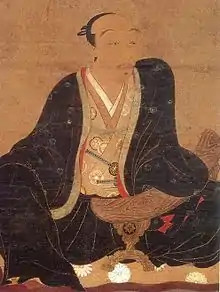 Maeda Toshiie | |
| Lord of Kaga | |
| In office 1583–1599 | |
| Succeeded by | Maeda Toshinaga |
| Personal details | |
| Born | Inuchiyo (犬千代) January 15, 1538 Arako, Japan |
| Died | April 27, 1599 (aged 61) |
| Nationality | Japanese |
| Spouse(s) | Maeda Matsu |
| Mother | Nagayowai-in (長齢院) |
| Father | Maeda Toshimasa |
| Military service | |
| Allegiance | |
| Unit | |
| Battles/wars | Battle of Okehazama Siege of Inabayama Battle of Anegawa Battle of Nagashino Battle of Tedorigawa Battle of Shizugatake Siege of Suemori Siege of Hachiōji Siege of Hachigata Siege of Odawara |
Early life
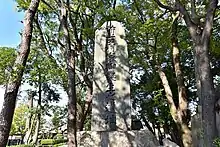
His father was Maeda Toshimasa and his wife was Maeda Matsu. His childhood name was "Inuchiyo" (犬千代). Toshiie was born in the village of Arako (present-day Nakagawa-ku, Nagoya),[1] He was the fourth of seven brothers, of Maeda Toshimasa, who held Arako Castle. Toshiie served Oda Nobunaga from childhood (first as a page) and his loyalty was rewarded by being allowed to be the head of the Maeda clan, very unusual for a fourth son with no apparent failures among his elder brothers. Just like Nobunaga, Toshiie was also a delinquent, usually dressed in the outlandish style of a kabukimono. It is believed he also became a friend to Kinoshita Tokichiro (later Toyotomi Hideyoshi) in their youth. Just as Hideyoshi was known as Saru, 猴 or "monkey," it is believed that Toshiie was called Inu, 犬 or "dog" by Nobunaga. Due to a long-standing belief that dogs and monkeys are never friendly to each other, Toshiie is often depicted as reserved and stern, in contrast to Hideyoshi's talkative and easy-going nature.
Military life
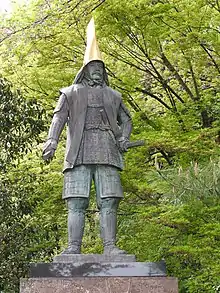
Toshiie began his career as a member of the akahoro-shū (赤母衣衆), the unit under Oda Nobunaga's personal command. He later became an infantry captain (ashigaru taishō 足軽大将) in the Oda army. During his military career, Toshiie made the acquaintance of many important figures, such as Hashiba Hideyoshi,[1] Sassa Narimasa, Niwa Nagahide, Ikeda Tsuneoki, and others. Toshiie also was a lifelong rival of Tokugawa Ieyasu. After defeating the Asakura clan, Maeda fought under Shibata Katsuie in the Hokuriku area.
He participated in the 1560 Battle of Okehazama, the 1567 Siege of Inabayama, the 1570 Battle of Anegawa, the 1575 Battle of Nagashino, the 1577 Battle of Tedorigawa. He was eventually granted the fief of Fuchu, and a han (Kaga Domain) spanning Noto and Kaga Provinces.[2] Despite its small size, Kaga was a highly productive province which would eventually develop into the wealthiest han in Edo period Japan, with a net worth of 1 million koku (百万石); thus, it was nicknamed Kaga Hyaku-man-goku (加賀百万石).
Toshiie benefited from a core group of very capable senior vassals. Some, like Murai Nagayori and Okumura Nagatomi, were retainers of long standing with the Maeda.
After Nobunaga's assassination at Honnō-ji (本能寺) by Akechi Mitsuhide and Mitsuhide's subsequent defeat by Hideyoshi, he battled Hideyoshi under Shibata's command in the Battle of Shizugatake 1583. After Shibata's defeat, Toshiie worked for Hideyoshi and became one of his leading generals. Somewhere during this time he was forced to fight another of his friends, Sassa Narimasa. Narimasa was greatly outnumbered and felled by Toshiie, following the major Maeda victory at the Battle of Suemori Castle 1584. Later, he fought in the Odawara Campaign 1590.
Death
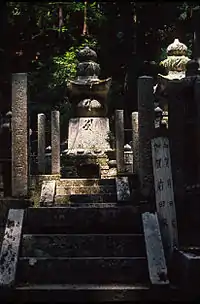
Before dying, in 1598 Hideyoshi named Toshiie to the council of Five Elders to support Toyotomi Hideyori until he was old enough to take control on his own.[3] However, Toshiie himself was ailing, and could manage to support Hideyori for only a year before he died as well in 1599. Toshiie was succeeded by his son Toshinaga.
Family
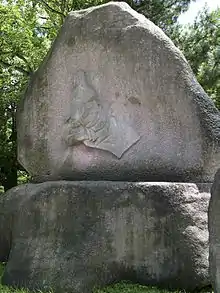
- Father: Maeda Toshimasa
- Mother: Nagayowai-in (d.1573)
- Siblings:
- Maeda Toshihisa (d. 1583)
- Maeda Yasukatsu (d. 1594)
- Maeda Toshifusa
- Sawaki Yoshiyuki (d. 1572)
- Maeda Hidetsugu (d. 1585)
- Maeda Masa (given in marriage to Takabatake Sadayoshi)
Toshiie's wife, Maeda Matsu, was famous in her own right. Strong-willed from childhood, she was well-versed in the martial arts and was instrumental in Toshiie's rise to success. After her husband died, Matsu, then known by her Buddhist nun name of Hoshun-in, assured the safety of the Maeda clan after the year 1600 by voluntarily going as a hostage to Edo, capital of the new shōgun, Tokugawa Ieyasu, whom she loathed throughout her life as she watched him, her husband, and Hideyoshi compete for power.
- Wives,Concubines,Children:
- Wife: Maeda Matsu
- First Son: Maeda Toshinaga
- First Daughter: Kō (1559–1616) married Maeda Nagatane
- Second daughter: Sho married Nakagawa Mitsushige
- Third daughter: Maa (1572–1605) become Toyotomi Hideyoshi’s concubine later married Madenokoji Atsufusa
- Fourth daughter: Gō (1574–1634) married Ukita Hideie
- Fifth Daughter: Yome, Asano Yoshinaga's fiancée
- Second Son: Maeda Toshimasa (1578-1638)
- Seventh Daughter: Chise (1562–1614) married Hosokawa Tadataka later married Murai Nagatsugu
- Concubine: Chiyobo (1570-1631) later Kinsein
- Concubine: Ryujoin
- Kikuhime (1578–1584)
- Yoshi married Shinohara Sadahide
- Concubine: Kinsein
- Fuku married Tyou Yoshitsura later married Nakagawa Mitsutada
- Maeda Tomoyoshi (1591-1628)
- Concubine: Jufuku-in
- Maeda Toshitaka (1594–1637)
- Concubine: Kaishoin
- Maeda Toshisada (1598-1620)
- Nephew: Maeda Toshimasu (1543-1612)
- Wife: Maeda Matsu
Their sons all became daimyōs in their own right. Their daughters married into prestigious families; the eldest, Kō, married Maeda Nagatane, a distant relative of Toshiie who became a senior Kaga retainer; Ma'a, was a concubine of Toyotomi Hideyoshi later Married Marikouji Mitsurubo,[3] Gō was adopted by Hideyoshi and became the wife of Ukita Hideie,[3][4] and Chise, who was first wedded to Hosokawa Tadaoki's son Tadataka, later married Murai Nagayori's son Nagatsugu. Sho married Nakagawa Mitsushige. Toshi married Shinohara Sadahide. Fuku married Nakagawa Mitsutada.
Ōdenta sword
"Ōdenta" or "Great Denta" or "The Best among Swords Forged by Denta". Owned by Maeda Ikutokukai. Along with Onimaru and Futatsu-mei, the sword was considered to be one of the three regalia swords of the shoguns of the Ashikaga clan. Later passed down to Maeda Toshiie. A legend says the sword healed a daughter of Toshiie and another legend says birds never try to approach to a warehouse where this sword is stored.
In popular culture
He is a playable character in video game Sengoku Basara 2 (PS2) and an unplayable character in video game Sengoku Basara 4 (PS3). He wields a large Nodachi and fire-based attacks. In anime, they were initially servants of Oda Nobunaga, later turned to Toyotomi Hideyoshi. He is a playable character in the video game "Samurai warriors 2 Extreme legends" (PS2) and appears in every major samurai warriors title following his first appearance . He wields a single sword and twin spears.
Honours
- Junior First Rank (24 March 1599; posthumously)
Further reading
- Hanagasaki Moriaki 花ケ前盛明, ed. Maeda Toshiie no Subete 前田利家のすべて. Tokyo: Shin Jinbutsu Ōraisha 新人物往来社, 2001.
- Iwasawa Yoshihiko 岩沢愿彥. Maeda Toshiie 前田利家. Tokyo: Yoshikawa Kōbunkan 吉川弘文館, 1966.
- Kitamura Saburō 北村三郎. Maeda Toshiie monogatari: Kaga hyakumangoku no so 前田利家物語:加賀百万石の祖. Kanazawa: Hokkoku Shuppansha 北国出版社, 1978.
- Maeda Toshiyasu 前田利祐. Omatsu to Toshiie: Kaga hyakumangoku wo tsukutta hitobito おまつと利家:加賀百万石を創った人びと. Tokyo: Shūeisha 集英社, 2001.
- Tsumoto Yō 津本陽. Maeda Toshiie 前田利家. Tokyo: Kōdansha 講談社, 1994.
References
- Turnbull, Stephen (2005). Samurai Commanders (2). Osprey Publishing. pp. 23–27. ISBN 9781841767444. Retrieved 22 October 2014.
- Turnbull, Stephen (2000). The Samurai Sourcebook. London: Cassell & C0. p. 55,228. ISBN 1854095234.
- Frédéric, Louis (2002). Japan Encyclopedia. Harvard University Press. p. 601. ISBN 9780674017535. Retrieved 22 October 2014.
- Women in the Lusophone World in the Middle Ages and the Early Modern Period. Baywolf Press. 2007. p. 434. Retrieved 22 October 2014.
- Turnbull, Stephen (1977). The Samurai. New York: Macmillan Publishing Co., Inc. pp. 156–160. ISBN 9780026205405.
External links
- Buke-kaden page on the Maeda clan (in Japanese)
- Maeda Genealogy (in Japanese)
- Genealogy of Kanazawa-han daimyo, including Toshiie (in Japanese)
- Biography (in Japanese)
| Preceded by none |
Lord of Kanazawa (Kaga Domain) 1583–1599 |
Succeeded by Maeda Toshinaga |
